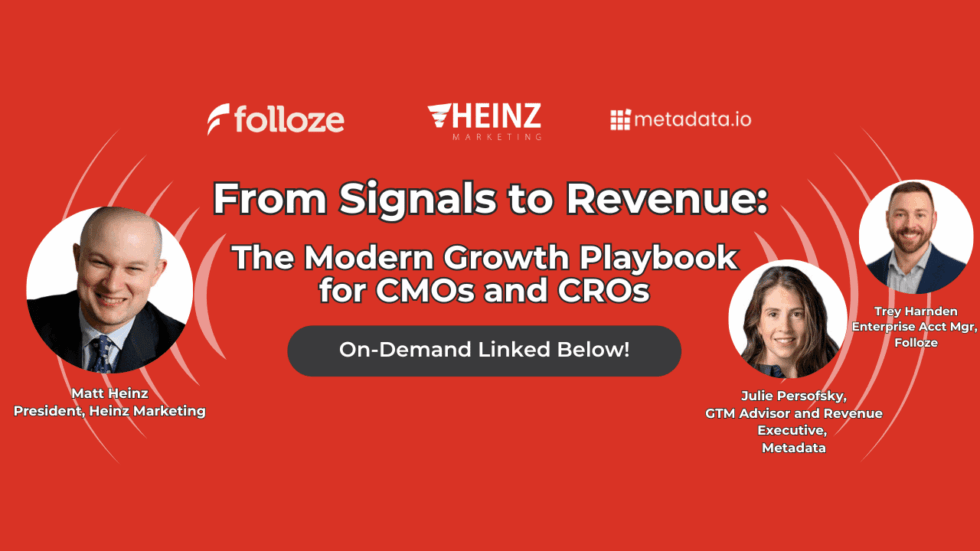Webinar Recap: “From Signals to Revenue: The Modern Playbook from CMOs and CROs”

Summary
Buyers are signaling their needs long before they ever raise their hand. In this expert-led on-demand session, you'll learn how CMOs and CROs are using intent and behavioral data to align their teams, drive smarter plays, and create more predictable growth.
Most revenue teams still rely on surface-level engagement to steer their go-to-market efforts. But the truth is, using buyer signals to drive growth—both with prospects and customers—offers far more insight and impact when done well.
That’s what we explored in “From Signals to Revenue: The Modern Growth Playbook for CMOs and CROs,” an on-demand session hosted by Heinz Marketing’s President Matt Heinz, with guest speakers Julie Persofsky (Growth Advisor, Metadata), and Trey Harnden (Enterprise Account Manager, Folloze), the discussion centered on how B2B teams are turning behavioral and intent signals into pipeline, revenue, and stronger customer relationships.
If you didn’t catch it live, you can watch the full session here.
What’s Getting Missed (and What to Do About It)
Your prospects and customers leave behind useful signals constantly via content engagement, platform activity, buying committee research, and more. But most teams either aren’t tracking those signals well, or don’t have a clear plan for acting on them.
The panel called out a few specific gaps they see even among mature revenue teams:
- Most GTM teams still treat signals as a lead-gen tool. But the best-performing organizations are using them across the entire customer lifecycle from first touch to expansion and renewal.
- There’s too much emphasis on collecting data, and not enough on applying it. Signals aren’t valuable unless they trigger something actionable and measurable.
- Sales and customer success often get left out of the loop. Even when marketing is doing a good job surfacing insights, they often don’t make it into the hands of the people who can act in time.
What Leading Teams Are Doing Differently
Rather than trying to boil the ocean, successful teams narrow in on signal categories that tie directly to revenue moments and align cross-functional plays around them. The panel walked through examples of how this shows up across different teams:
For Marketing
- Tailoring nurture paths based on engagement patterns and content interest
- Weighting lead scoring with intent and behavioral data (not just email opens or pageviews)
- Building modular content journeys that evolve as new signals come in
For Sales
- Triggering outreach based on high-value actions (like repeat product page views or competitor comparisons)
- Equipping reps with “why now” context, not just account names
- Using signals to prioritize outreach timing and messaging
For Customer Success
- Monitoring platform usage and support patterns to flag expansion opportunities or churn risk
- Aligning renewal and upsell plays with in-product behavior
- Using low-lift engagement (like resource nudges or check-ins) tied to specific signals
A Few Real-World Examples of Using Buyer Signals to Drive Growth
The conversation also touched on how teams are putting these ideas into practice:
- A SaaS company identified a rise in usage of premium features among a segment of customers. That signal prompted a proactive outreach from CS that sped up renewals and opened expansion conversations earlier than usual.
- Another team combined first-party engagement (like pricing page activity) with third-party intent (visiting competitor sites) to build 1:1 outbound campaigns. Their conversion rate from previously cold accounts more than doubled.
- One org used signal thresholds to automate internal routing, ensuring accounts showing high buying intent were flagged to sales and removed from nurture, streamlining follow-up and avoiding channel conflict.
What CMOs and CROs Should Take Away
Getting value from intent data—and truly using buyer signals to drive growth—isn’t about having the most tools or tracking the most behaviors. It’s about:
- Defining which signals matter and why; what do they indicate, and what outcome should they tie to?
- Aligning teams around those signals; ensure marketing, sales, and CS aren’t duplicating efforts or missing handoffs
- Turning signals into plays; ideally pre-defined and repeatable, so teams can move quickly without needing to reinvent the wheel
- Measuring impact clearly; look beyond surface metrics and ask: which signals actually correlate to revenue movement?
For revenue leaders, that might mean starting with a signal audit, refreshing your scoring model, or rethinking how expansion plays get triggered. The common thread is making signals usable, not just visible.
Final Thoughts
Too many teams are sitting on valuable insight without a clear way to act. This session showed how a few key changes—better alignment, more focused signal strategies, and practical playbooks—can make a real difference in both pipeline and customer growth.
You can watch the full webinar on-demand here for deeper examples and insights and for access to our growth resources. If you have any questions after watching our on-demand webinar and reading through our content, send us an email!






